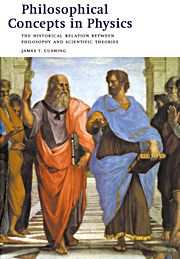 Philosophical Concepts in Physics
Philosophical Concepts in Physics Book contents
- Frontmatter
- Contents
- Preface
- Copyright acknowledgments
- PART I The scientific enterprise
- PART II Ancient and modern models of the universe
- PART III The Newtonian universe
- PART IV A perspective
- 10 Galileo's Letter to the Grand Duchess
- 11 An overarching Newtonian framework
- 12 A view of the world based on science: determinism
- PART V Mechanical versus electrodynamical world views
- PART VI The theory of relativity
- PART VII The quantum world and the completeness of quantum mechanics
- PART VIII Some philosophical lessons from quantum mechanics
- PART IX A retrospective
- Notes
- General references
- Bibliography
- Author index
- Subject index
11 - An overarching Newtonian framework
Published online by Cambridge University Press: 05 June 2012
- Frontmatter
- Contents
- Preface
- Copyright acknowledgments
- PART I The scientific enterprise
- PART II Ancient and modern models of the universe
- PART III The Newtonian universe
- PART IV A perspective
- 10 Galileo's Letter to the Grand Duchess
- 11 An overarching Newtonian framework
- 12 A view of the world based on science: determinism
- PART V Mechanical versus electrodynamical world views
- PART VI The theory of relativity
- PART VII The quantum world and the completeness of quantum mechanics
- PART VIII Some philosophical lessons from quantum mechanics
- PART IX A retrospective
- Notes
- General references
- Bibliography
- Author index
- Subject index
Summary
In modern science we judge a theory by its ability to make detailed quantitative predictions within some domain (vertical coherence) and we also look for applications across various fields outside its original domain (horizontal coherence). In this way we generate a coherent network of concepts, laws and theories that is usually taken to be a sign of a correct representation of the phenomena of nature. The present chapter recapitulates our exposition of the discovery and development of the law of universal gravitation as a useful illustration of this process and discusses how this became interwoven with our ideas about space and time. Here we tell a retrospective story in which facts are selectively arranged in a sequence to produce a hopefully coherent narrative. This, of course, does not imply that there was any inherent need that events had to develop as they did.
A REVOLUTION
As we have seen (Sections 4.5 and 4.7), in the Aristotelian view of the cosmos the earth was at the center of the celestial sphere and all the space between these was divided into concentric regions (the homocentric spheres of Eudoxus), each region being the domain of one of the planets. This system of spherical regions turned one within the other to account for the observed motions of the stars and planets. The entire system was driven by the motion of the outermost shell, the celestial sphere.
Information
- Type
- Chapter
- Information
- Philosophical Concepts in PhysicsThe Historical Relation between Philosophy and Scientific Theories, pp. 148 - 163Publisher: Cambridge University PressPrint publication year: 1998